Reorganization of an occlusion in a mutilated dentition is the most challenging task which is ever faced by prosthodontists. An occlusal rehabilitation, though it is common, is the most complex treatment procedure which is widely practised in treating severely worn out dentitions, developmental anomalies, acquired defects, ill fitting, long span fixed partial dentures and TMJ disorders. Various factors such as vertical dimension of occlusion, centric relation, occlusal contact pattern, aesthetics and phonetics need to be considered simultaneously for both anterior and posterior teeth during occlusal rehabilitations. Different schools of thoughts have been documented for rehabilitation of such cases and the choice of the treatment plan depends on the skill and experience of the clinician. This clinical report describes the full mouth rehabilitation of a severely worn out dentition, in functional harmony with the stomatognathic system. Hobo’s Twin-stage procedure was adopted to produce a definite amount of disocclusion during eccentric movements.
Case Report
A 55-year-old male patient reported to the Department of Prosthodontics, Kamineni Institute of Dental Sciences, Narketpally, India with chief complaint of excessive tooth wear, with difficulty in chewing and discoloured teeth. The patient gave a history of gradual wearing of teeth over almost a decade. On examination, there was generalized attrition, poor aesthetics, sensitivity of teeth, chewing difficulties and loss of tooth substance due to chipping and wearing .Both the arches were fully dentate, with spacing between maxillary and mandibular anterior teeth. The patient had a bilateral class I molar relation and a canine-guided occlusion. Approximately 3 mm of loss was established in VDO. The case was diagnosed as “Mutilated dentition with reduced vertical dimensions due to severe attrition” [Table/Fig-1].
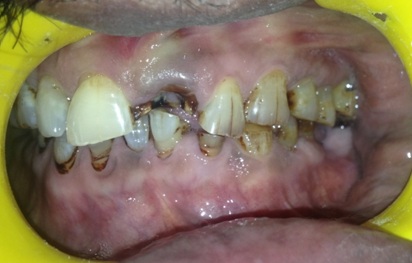
Diagnostic impressions were made by using alginate. Face bow records, along with cast, were mounted on a Hanau Wide Vue semi adjustable articulator. A modeling compound, an anterior deprogramming jig was made and centric relation was recorded by using polyether bite registration material. A diagnostic wax up was done to analyze the need of altering the vertical dimension of occlusion, occlusal plane, tooth contour position and aesthetics.
Minimal occlusal reduction is indicated for patients who are scheduled for rehabilitation at an altered VDO. Teeth preparations for full coverage metal ceramic crowns were completed for the entire dentition. Full-arch impressions were made by using addition silicone in a single step putty wash technique. A Hobo’s twin stage technique for full mouth reconstruction, with the occlusal scheme as group function, was selected as the treatment of choice. A cast with a removable anterior and posterior segment is required.
In this technique, occlusal morphology of the posterior teeth is established without the anterior segment. For this, articulator was programmed to condition I of twin stage procedure, where the values of sagittal condylar path and Bennett angle, were set to 25 degrees and 15 degrees respectively. The values of anterior guide table, that is, the sagittal inclination and lateral wing angle were adjusted to 25 and 10 degrees respectively. At this position, the diagnostic wax-up was balanced in protrusive and lateral excursions. The anterior segment of the cast was reassembled, the condylar guidance and incisal guidance were set again (condition 2) and the wax-up was completed, so as to generate posterior disocclusion. [Table/Fig-2,3]. At condition II, the Hanau semi-adjustable articulator was adjusted, with sagittal condylar path and Bennett angle being set at 40 degrees and 15 degrees respectively. The value of anterior guide table was set, with the sagittal inclination and lateral wing angle being set at 45 degrees and 0 degrees respectively. Provisional restorations were made with heat polymerizing acrylic resin which was derived from the wax-up template from above mentioned procedure. Provisional crowns were then cemented with zinc oxide non-eugenol. The interim restorations were kept for 45 days to assess the patient’s adaptation to the proposed new occlusal scheme and vertical dimension of occlusion, which was raised by 3 mm [Table/Fig-4,5]. Once the patient was satisfied with temporary restorations, the definitive cast was fabricated. The final prostheses were fabricated on the definitive cast by using the same values that were used to fabricate temporary prosthesis. The porcelain fused to metal restoration was corrected for occlusal prematurity in the mouth and it was finally cemented. On frequent recalls, patient gave satisfactory reviews with the treatment which was provided [Table/Fig-6].
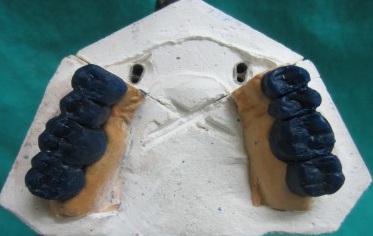
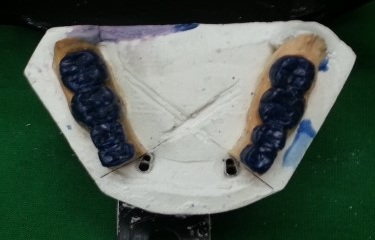
Group function at excursive movements (temporaries)
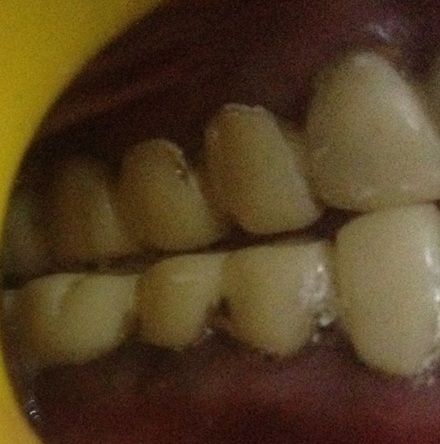
Group function at excursive movements (temporaries)
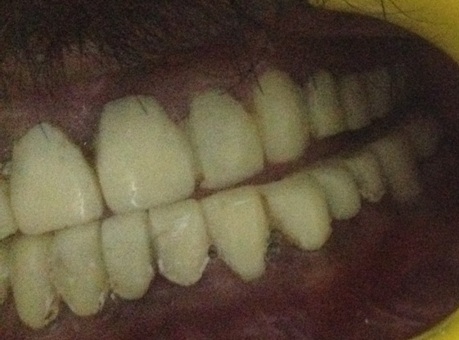
Post operative definite prosthesis
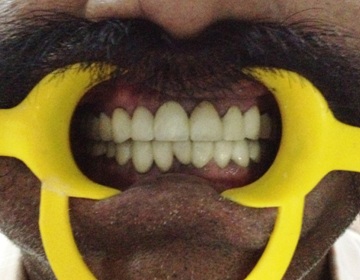
Discussion
Occlusal rehabilitation deals with the restoration of functional integrity of dental arches by the use of inlays, crowns, FPDs and partial dentures. The primary objective of full mouth rehabilitation is preservation of health, restoring function and achieving aesthetics and patient comfort. A systematized and integrated approach is required for a prognosis that is favourable and predictable [1].
As was stated by D Amico, cuspid protected occlusions and disocclusions were natural adaptations which were used for preventing destructive occlusions [2]. Added to the aesthetics and comfort, the other important factor which has to be taken into consideration is disocclusion of teeth during excursions which would preserve the integrity of entire stomatognathic system, thus resulting in a long lasting, functional restoration.
As per literature, condylar guidance and anterior guidance are considered as primary determinants of occlusal rehabilitations [1,3]. The technique which was used in this case for occlusal rehabilitation of a severely worn dentition (HOBO technique), describes the method of reorganizing an occlusion by using cuspal angle as the primary determinant.
In prosthodontics, the condylar path of the patient is used as the main occlusal determinant. However, research has found that the condylar paths have deviations and that they exert minor influence on disocclusion [4]. This deviation is greatly influenced by anterior guidance.
To investigate whether the incisal path was reliable, the data for incisal path inclination in normal individuals, which was measured by different researchers by using an electronic measuring system were compared and results indicated that 32% of the sagittal protrusive incisal path inclination was less than 35 degrees or greater than 55 degrees of its mean value (45 degrees) [5]. Furthermore, the occurrence rates of malocclusions in a randomly selected population showed that one out of five patients did not have an incisal path that reflected an appropriate standard [6].
The last factor which had to be considered was the cusp angle. Since precise three-dimensional data of effective cusp angles are not available in dentistry, the measured amount of disocclusion was used for computation. These values that were obtained mathematically were grouped according to the occlusal scheme that was chosen for each patient. The cusp part was obtained by the valve of the cusp angle, that could be estimated by a standard amount of disocclusion [7].
The case which has been mentioned above was planned for a group function occlusal scheme, wherein the posterior cuspal morphology was contoured as per standard values formulated by the author of twin stage technique [5,7].
Later, anterior guidance was also established according to the standard values, to disocclude the posteriors in protrusive and laterotrusive movements.
On the whole, in this kind of group function occlusion scheme, all the upper and lower posteriors on the working side function like a group, simultaneously disoccluding the upper and lower posteriors on the contralateral, non working side, thus, preventing lateral stresses on the non working side. This fulfills the requirements of an ideal occlusion, for a harmonious functioning of the stomatognathic system.
Conclusion
This technique relies on the factor of cuspal angle and it uses the standard values which are proposed in the twin stage technique, to achieve a centric occlusion and an excursive disocclusion. Condylar path has always been regarded as a key determinant of occlusion. However, according to the work of Hobo and Takayama, condylar path has been shown to have a deviation and it exerts a minor influence on disocclusion. However, it was found that with every degree of rise in the horizontal condylar guidance, the amount of disocclusion was increased by only 0.020 mm during protrusion, by 0.015 mm on nonworking side and by -0.002 mm on the working side. Thus, the cusp angle and the anterior guidance are more important determinants for achieving a disocclusion and use of average angulations of the horizontal condylar guidance can be successfully used to achieve a mutually protected occlusion [8]. However, the choice of selecting the method for rehabilitation of the occlusion is case specific, with respect to operator convenience and clinical skills.
A combination of new generation materials, along with improved clinical procedures, works in tandem to produce an aesthetic, long-lasting, and functional outcome, which satisfies both the clinician as well as the patient [9].
[1]. Dawson P, Functional occlusion from TMJ to smile design 2007 St. LouisMosby [Google Scholar]
[2]. Damico A, Function occlusion of natural teeth in man J Prosthet Dent 1961 11:899-915. [Google Scholar]
[3]. Mann AW, Pankey LD, The P.M. philosophy of occlusal rehabilitation Dent Clin North Am 1963 7:621-38. [Google Scholar]
[4]. Hobo S, Oral rehabilitation. Clinical determination of occlusion 1997 LondonQuintessence Publishing [Google Scholar]
[5]. Hobo Sumiya, Takayama Hisao, Twin-Stage Procedure. Part 1: A New Method to Reproduce Precise Eccentric Occlusal Relations Int J Periodont Rest Dent 1997 17:113-23. [Google Scholar]
[6]. Kelly JE, Sanchez M, van Kirk LE, An assessment of the occlusion of teefh of children. (Data from the National Health Survey: DHEW Publication no. CHRA) 74-1612 National Center for Health Statistics 1973 US Public Health Service [Google Scholar]
[7]. Hobo Sumiya, Takayama Hisao, Twin-Stage Procedure. Part 2: A Clinical Evaluation Test Int J Periodont Rest Dent 1997 17:457-63. [Google Scholar]
[8]. Shetty Manoj, Joshi Niranjan, Prasad D Krishna, Sood Sonali, Complete Rehabilitation of a Patient with Occlusal Wear: A Case Report J Indian Prosthodont Soc 2012 12(3):191-97. [Google Scholar]
[9]. Hegde Chethan, Prasad Krishna D, Jacob Sunil J, Shetty Manoj, Full mouth rehabilitation of a severelyworn out dentition to functional harmony The Journal of Indian Prosthodontic Society 2009 9(3):164-66. [Google Scholar]